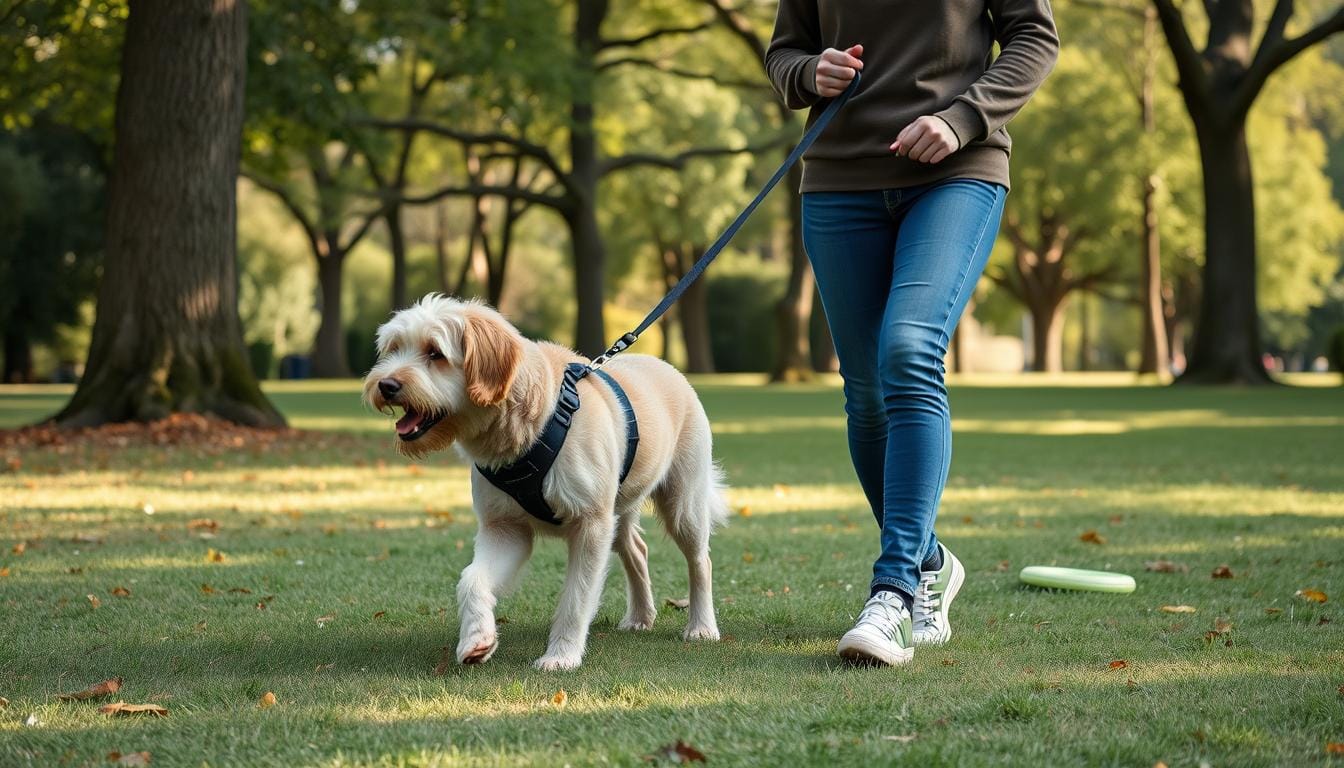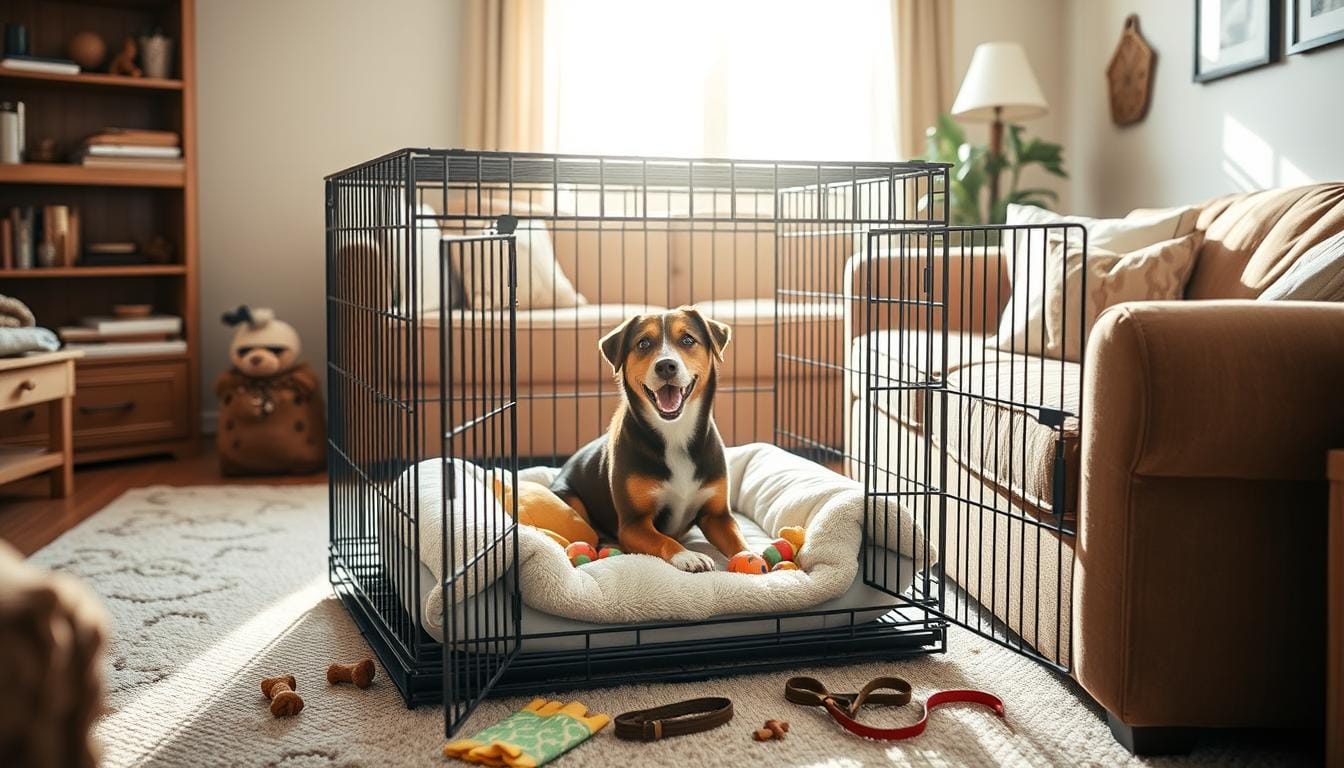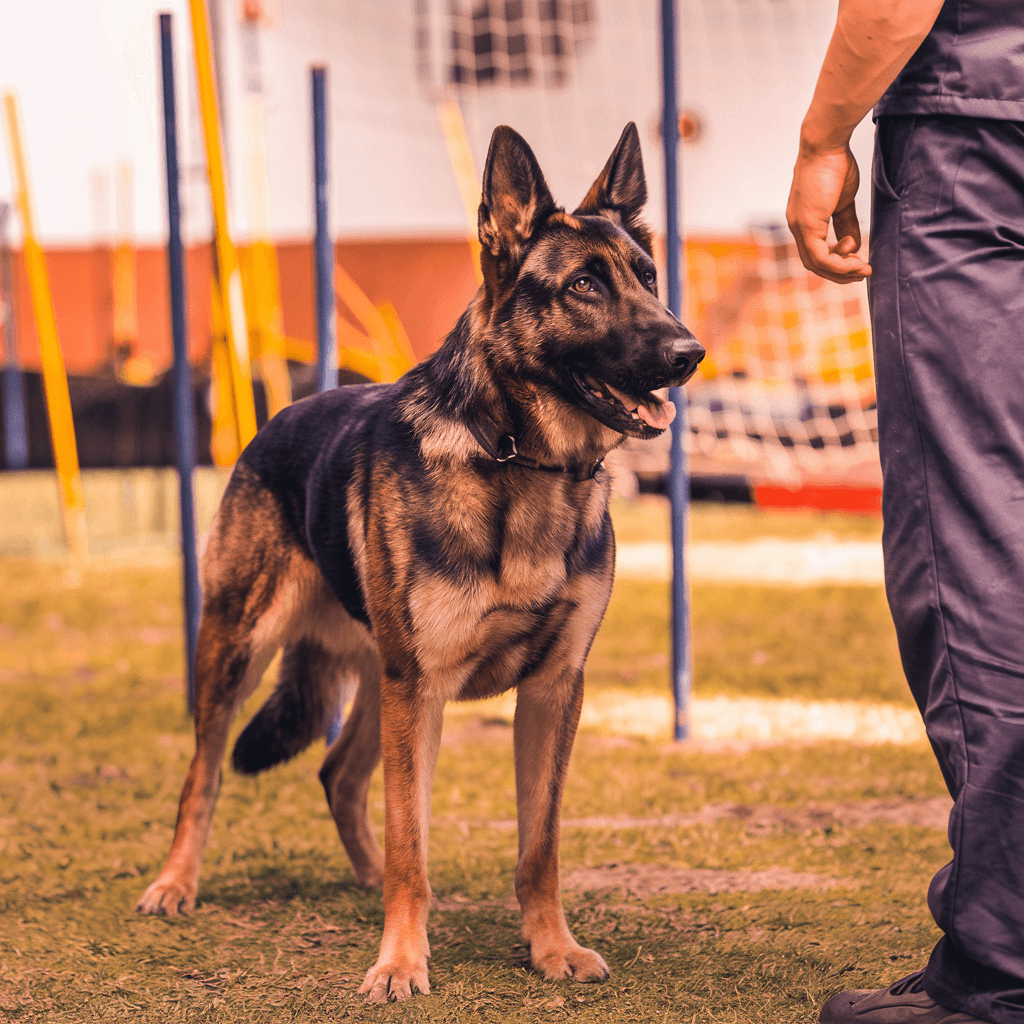Did you know dogs can sense human emotions instinctively? It’s true! Dogs have an amazing ability to sense our feelings. They often respond with their own subtle cues, including their breathing.
When it comes to dog breathing issues, pet owners often get worried. A healthy dog usually breathes 15 to 35 times per minute when resting. If they breathe more than 40 times per minute, it could mean they’re not feeling well.
Panting is how dogs cool down since they can’t sweat like we do. But if they’re breathing fast when they’re not active, it might be a sign of a problem. Many things can cause this, like their breed or the environment they’re in.
Exploring the bond between humans and dogs can be fascinating. Learning about their breathing patterns helps us care for them better. It also strengthens our connection with our furry friends.
Key Takeaways
- Normal dog breathing rate: 15-35 breaths per minute at rest
- Breathing above 40 breaths per minute at rest is abnormal
- Panting helps dogs regulate body temperature
- Brachycephalic breeds are prone to breathing issues
- Rapid breathing can indicate various health problems
- Signs of respiratory distress require immediate vet attention
- Diagnosis may involve physical exams and tests like X-rays
What is Considered Fast Breathing in Dogs?
It’s important to know how your dog breathes to keep them healthy. You might ask yourself why is my dog breathing fast or if it’s okay. Let’s explore what’s normal and what’s not for our furry friends.
Normal Respiratory Rates for Dogs
A healthy dog usually breathes 15 to 35 times a minute when they’re resting. This number can change based on their size, age, and how active they are. Watching your dog’s breathing can help you catch problems early.
| Breathing Rate | Status |
|---|---|
| 15-30 breaths/minute | Normal |
| 31-35 breaths/minute | Borderline |
| Above 40 breaths/minute | Abnormal |
Signs of Abnormal Breathing
Dogs pant to cool down, but too much panting when they’re not active can be a sign of trouble. Look for signs like hard breathing, pale gums, or breathing with their mouth open when they’re calm. These could mean they have breathing problems.
How to Measure Your Dog’s Breathing Rate
To measure your dog’s breathing rate:
- Wait until your dog is sleeping or resting calmly.
- Count their chest movements (each rise and fall is one breath) for 60 seconds.
- Record this number and repeat a few times for accuracy.
If you always count over 35 breaths per minute, it’s time to see the vet. Some breeds, especially those with flat faces, are more likely to have breathing problems.
Common Causes of Rapid Breathing in Dogs
Rapid breathing in dogs can signal many health issues. It’s important to know what these are to help our dogs breathe better. A normal dog breathes 15 to 35 times per minute when resting. Breathing more than 40 times a minute is not normal.
There are several reasons why dogs might breathe fast:
- Respiratory infections (bacterial or fungal)
- Asthma and lung diseases
- Laryngeal paralysis
- Tracheal collapse
- Heat stroke
- Pain or anxiety
- Anemia
- Medications
Some dog breeds are more likely to have breathing problems. For example, Boston Terriers and Pugs often face respiratory issues. Labrador Retrievers might have laryngeal paralysis, while Chihuahuas are at risk for tracheal collapse.

If a dog shows signs of trouble breathing, like blue gums or fast, shallow breaths, get vet help right away. Tests like X-rays can find problems in the heart, lungs, or belly. Treatment can include medicines, oxygen, or surgery, depending on the issue.
By being aware of these common causes, we can help our dogs breathe better. This way, we can make sure they get the care they need when they need it.
Dog Breathing Issues: Breed-Specific Considerations
Different dog breeds face unique health challenges, especially with dog breathing issues. Knowing these breed-specific considerations is key for every dog owner. It ensures their furry friend’s well-being.
Brachycephalic Breeds and Respiratory Challenges
Brachycephalic breeds have flat faces and short snouts. They often struggle with Brachycephalic Airway Syndrome. This makes it hard for them to breathe normally and can be serious.
These dogs have stenotic nares, elongated soft palates, and everted laryngeal saccules. In bad cases, surgery might be needed to fix these problems.
Other Breeds Prone to Breathing Problems
While brachycephalic breeds often have breathing issues, other dogs can too. Genetics, environment, and health all affect a dog’s breathing.
Remember, regular vet check-ups are essential for all breeds to catch and address potential breathing problems early.
Here’s a comparison of lifespan and surgery costs for some breeds prone to breathing issues:
| Breed | Average Lifespan | Surgery Cost Range |
|---|---|---|
| Brachycephalic Breeds | 8-10 years | $3,000-$5,000 |
| Non-Brachycephalic Breeds | 10-13 years | $1,000-$3,000 |
By understanding these breed-specific considerations, we can better care for our dogs. We can address their unique health needs.
When to Be Concerned About Your Dog’s Breathing

As pet owners, we often wonder why is my dog breathing fast. It’s important to know when to worry about your dog’s breathing. Dogs usually breathe 15-30 times per minute when they’re calm. If your dog breathes more than 30 times per minute often, it’s a sign to pay attention.
Rapid breathing can happen after exercise or when your dog is excited. But if your dog breathes heavily while resting or at night, it could be a serious health issue. Look for signs like labored breathing, using stomach muscles to breathe, or breathing with their mouth open at rest.
Gum color changes are also a warning sign. If your dog’s gums are pale, blue-tinged, or brick-red, you need to get vet help right away. If your dog is not eager to eat, drink, or move, and they drool a lot, it’s time to seek professional help.
“There are no home remedies for heavy breathing in dogs. Immediate veterinary attention is necessary.”
Some breeds, like bulldogs and pugs, are more likely to have breathing problems. Being overweight can also put a strain on a dog’s breathing. Watch out for environmental factors like allergens and hot weather, as they can make breathing harder.
| Normal Breathing | Concerning Breathing |
|---|---|
| 15-30 breaths per minute | More than 30 breaths per minute |
| Regular, effortless breaths | Labored breathing, using stomach muscles |
| Normal gum color | Pale, blue-tinged, or brick-red gums |
| Active and alert | Reluctance to eat, drink, or move |
Remember, heavy breathing at rest is often a medical emergency. If you’re unsure about your dog’s breathing, always check with a vet. Regular vet visits can help keep an eye on your dog’s health and catch problems early.
Diagnosing the Cause of Fast Breathing in Dogs
Vets use many methods to find out why dogs breathe fast. Knowing these steps helps pet owners understand their dog’s health better.
Physical Examination
A detailed physical exam is the first step. Vets check the heart, lungs, and overall health. They listen for odd sounds and look for signs of pain or distress.
Diagnostic Tests
More tests might be needed. X-rays show lung tumors or broken ribs. Blood tests check for infections or metabolic issues. Sometimes, CT scans or ultrasounds are used too.
Medical History Importance
A dog’s past health is very important. Owners should share any recent changes or factors that might affect breathing. This helps vets make the right diagnosis and treatment plan.
| Diagnostic Method | Purpose |
|---|---|
| Physical Examination | Assess overall health and detect obvious abnormalities |
| X-rays | Identify lung or chest issues |
| Blood Tests | Detect infections or metabolic problems |
| Medical History Review | Provide context for symptoms and potential causes |
Vets use these tools to find why dogs breathe fast. They then create plans to help their health.
Treatment Options for Rapid Breathing in Dogs
Vets create treatment plans based on the cause of dog breathing issues. Here are common treatments for different health concerns:
- Pain relief medications
- Intravenous fluids
- Antibiotics for infections
- Oxygen therapy
- Rest and restricted activity
- Behavioral training for stress-related issues
Some treatments can be done at home, while others need hospital care. The treatment depends on how serious the condition is.
For stress-related breathing, a dog behaviorist might be needed. They can help without using medication.
| Condition | Treatment |
|---|---|
| Asthma | Bronchodilators, corticosteroids |
| Pneumonia | Antibiotics, supportive care |
| Heat stroke | Cooling methods, IV fluids |
| Anemia | Blood transfusions, iron supplements |
A healthy dog breathes 15 to 35 times a minute when resting. If your dog breathes over 40 times a minute, see a vet. They can diagnose and treat the issue.
Preventing Breathing Problems in Dogs
It’s important to take steps to prevent breathing issues in dogs. We’ll look at ways to keep your dog breathing well and reduce health concerns.
Maintaining a Healthy Lifestyle
A balanced diet and regular exercise are key. Keeping your dog at a healthy weight helps their breathing. Daily walks and playtime strengthen their lungs and fitness.
Regular Veterinary Check-ups
Regular vet visits are crucial for catching breathing problems early. Your vet can check your dog’s breathing rate. A normal rate for dogs at rest is 10 to 30 breaths per minute.
Environmental Considerations
Make sure your dog’s environment is safe for breathing. Avoid smoke, strong chemicals, and dust. Be careful with brachycephalic breeds in hot weather or intense activity.
| Prevention Strategy | Benefits |
|---|---|
| Balanced Diet | Maintains healthy weight, reduces respiratory strain |
| Regular Exercise | Strengthens lungs, improves overall fitness |
| Vet Check-ups | Early detection of breathing issues |
| Clean Environment | Reduces exposure to irritants |
By following these preventive steps, we can lower the risk of breathing problems in dogs. This ensures our pets live healthy, active lives.
Home Care for Dogs with Respiratory Issues
Caring for dogs with breathing problems needs careful thought. We can help ease their breathing at home. A calm, cool space reduces stress on their lungs.
Using a humidifier can help dogs breathe better, especially with infections. Always follow your vet’s medication advice. Keep an eye on your dog’s breathing rate.
If symptoms get worse, seek emergency care right away.
For dogs with long-term breathing issues, work closely with your vet. Create a long-term plan that might include:
- Dietary adjustments
- Exercise modifications
- Regular health check-ups
Natural remedies can help too. Steam therapy, Manuka honey, and echinacea might offer relief. Keeping your dog hydrated is key for their breathing.
Also, keep their environment clean to avoid allergies. This helps prevent breathing problems.
While home care is vital, seeing a vet is crucial for a proper diagnosis and treatment. Always talk to your vet before trying new remedies or changing your dog’s care routine.
Conclusion
We’ve looked into dog breathing issues, a big part of dog health. Dogs can face many breathing problems, from their breed to the environment. It’s important for dog owners to know about these issues.
Acting fast is key when a dog has breathing trouble. Dogs can get worse quickly, so getting them to the vet fast is crucial. Vets might use oxygen cages to help, providing a safe space with 40-80% oxygen.
Don’t forget, there are eight main reasons dogs can have breathing problems. Things like heart issues and allergies can also cause trouble. Keep an eye on your dog’s breathing. If you see them breathing fast or wheezing, get help right away. Quick action can really help your dog’s health.
















